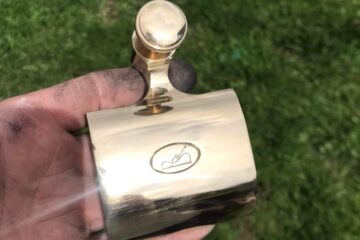Our methods of restoration aim to be sympathetic and minimal. We try to maintain patina, and wear and tear which provide authenticity and show the life the tool has lead. We don’t polish surfaces (unless a polished surface is functional). Our aim is to get tools back to a useable condition, as original as possible and present them in their best light – that’s all.
We disassemble everything to confirm it is ok. For example, handles and frogs are removed from planes, checked, cleaned and replaced.
Woodware restoration
Where possible we just clean wooden handles and tools. We will often remove paint splatters by scraping the surface leaving the underlying surface in tact. Where more aggressive cleaning is necessary we will use a range of chemicals (methylated spirits, acetone, etc) depending on the type of cleaning / refinishing required.
Where we refinish wood we tend to use shellac or wax, because they are traditional finishes easily removed. If we have to strip back the original finish we may oil the wood before applying shellac. We generally use tung oil, because it tends not to darken the wood, unlike linseed oil. Linseed oil is only used in repairs to blend new lighter coloured wood to old.
The listing will document all wood repairs (glue joints, complete refinishes, new wood, etc) we undertake. We also aim to document any repairs undertaken by others (providing we spot them – and we generally do).
Metalware restoration
Rust is typically removed by scraping, followed by a combination of wire wool and high grit (320+) wet and dry sandpaper and metal polish. We very rarely use power tools. We do sometimes use wire brushes, but we tend to use these on heavier castings. Typically, we do not paint metalware, we only clean it. The listing will identify any paint we have applied or any that we suspect a previous owner may have applied. Some of what we buy comes like that and if so we won’t strip it back.
We do not sell tools with critical flaws. Flaws are identified in the listing. We also take extensive high quality photographs so you can check for yourself.
If you want to know more read our article about cleaning rust from old tools.
Blade and edge sharpening
We tend to only sharpen blades to establish the condition of the edge. When we do this, we tend to sharpen blades to a minimum of 1000 grit on an abrasive stone. This is to reveal any pitting and ensure the blade will hold an edge. We rarely use power tools to sharpen unless water cooled. The Old Tool Shop has a hand powered grindstone to minimise the risk of blades getting too hot during sharpening, although we don’t use this often except for really damaged edges. We prefer to rely on our hand sharpening skills.
If we describe a tool as bench ready you will be able to use it without any work needed. Please note that this does not necessarily mean that it will meet your exacting standards, but it will be a fully working tool capable of making reasonable cuts.
Broken up for parts
We hate to break tools up for parts. The Old Tool Shop strongly believes that parts wear together and should stay together. We try to avoid replacing parts. Where we replace a part the write up will detail it. Where tools come into us with too many non-original or missing parts, they may be split up and sold in our parts section, but only as a last resort. We prefer not to do this, but sometimes it’s unavoidable.



0 Comments